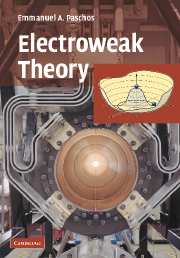Book contents
- Frontmatter
- Contents
- Preface
- Part I The road to unification
- Part II Field theories with global or local symmetries
- Part III Experimental consequences and comparisons
- 10 Deep inelastic scattering
- 11 Charged-current reactions
- 12 Neutral currents in semileptonic reactions
- 13 Physics of neutrinos
- 14 Heavy quarks
- 15 CP violation: K mesons
- 16 CP violation: D and B mesons
- 17 Higgs particles
- Epilogue
- Appendix A Conventions, spinors, and currents
- Appendix B Cross sections and traces
- Appendix C Identities for quark bilinears
- Index
14 - Heavy quarks
Published online by Cambridge University Press: 03 December 2009
- Frontmatter
- Contents
- Preface
- Part I The road to unification
- Part II Field theories with global or local symmetries
- Part III Experimental consequences and comparisons
- 10 Deep inelastic scattering
- 11 Charged-current reactions
- 12 Neutral currents in semileptonic reactions
- 13 Physics of neutrinos
- 14 Heavy quarks
- 15 CP violation: K mesons
- 16 CP violation: D and B mesons
- 17 Higgs particles
- Epilogue
- Appendix A Conventions, spinors, and currents
- Appendix B Cross sections and traces
- Appendix C Identities for quark bilinears
- Index
Summary
Introduction
When quarks were introduced into physics, they were considered to be light, like the up, the down, and the strange quarks. Their bound states were light mesons, such as the π and K mesons. In fact, light states were interpreted as the Goldstone bosons of the SU(3) symmetry with several of the aspects of Goldstone particles discussed in Chapter 5.
The next quark is the charm quark, which was formulated in order to suppress flavor-changing-neutral couplings in the K mesons (Glashow et al., 1970) (GIM henceforth). Since the charm quark is much heavier than the proton, its existence gave rise to the possibility that additional heavy quarks may exist. The expectation was confirmed with the discoveries of the bottom and top quarks when accelerators of higher and higher energies began operating.
The precise definition of quark masses is a delicate topic and for this reason we shall discuss some of the issues involved. Masses of fermions appear in the electroweak Lagrangian after the breaking of the symmetry, i.e. when the Higgs field acquires a vacuum expectation value. Masses for particles are measured through their interactions with an external field; for example, the bending of an electron beam in a magnetic field determines the ratio e/m. The interaction contains higher-order corrections, which must be included. For leptons the masses are defined as poles of the propagators. For quarks the situation is more complicated because they never appear as free particles, but are always confined within hadrons. The masses of quarks must include radiative corrections from the forces which confine them. On the energy scale of the heavy quarks the strong coupling constant is small enough to allow perturbative calculations.
- Type
- Chapter
- Information
- Electroweak Theory , pp. 155 - 179Publisher: Cambridge University PressPrint publication year: 2007

